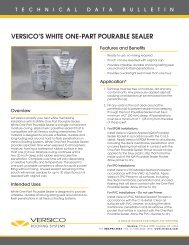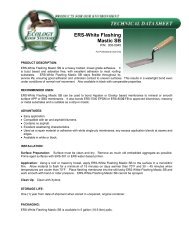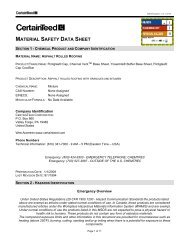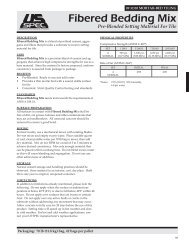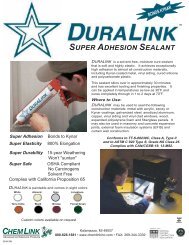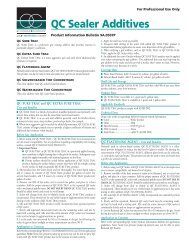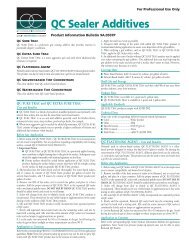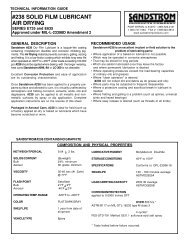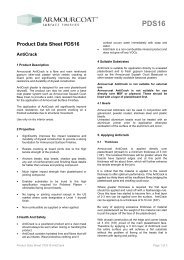Simpson Anchors - Anchoring and Fastening Systems - BuildSite.com
Simpson Anchors - Anchoring and Fastening Systems - BuildSite.com
Simpson Anchors - Anchoring and Fastening Systems - BuildSite.com
You also want an ePaper? Increase the reach of your titles
YUMPU automatically turns print PDFs into web optimized ePapers that Google loves.
Drill Bits<br />
220<br />
DRILL BIT WARRANTY CLAIMS Defi nitions & Procedures<br />
FAILURES:<br />
Warranty claims will occur on less than ¹⁄₂ of 1% of the <strong>Simpson</strong><br />
Strong-Tie Anchor <strong>Systems</strong> ® carbide-tipped bits used. This estimate is<br />
based on experience with many millions of bits in various tools <strong>and</strong> materials.<br />
The following information has been produced to enable you to<br />
improve your ability to fairly determine defects. BITS ARE WARRANTED FOR<br />
REPLACEMENT ONLY AND IN NO CIRCUMSTANCES WILL SIMPSON<br />
BE LIABLE FOR MERCHANTABILITY OR LOSS OF SERVICE.<br />
If the defect is not obvious, please return the bit to our home offi ce<br />
in Pleasanton, CA. Warranty decisions will be made within 48 hours after<br />
receiving the returned item(s).<br />
FOR BEST BIT WEAR LIFE / PRODUCTION OUTPUT<br />
USE THE FOLLOWING GUIDELINES:<br />
• Ensure that the tool holders are in good shape. Deformation of<br />
the slots or contours of the bit shanks are a positive indication<br />
of tool holder wear. Worn tool holders reduce rotational <strong>and</strong> energy<br />
transfer effi ciencies. Repair or replacement is required for<br />
effi cient hole production.<br />
• The lines of force should be kept as close as possible to 90° to the<br />
axis. The tool <strong>and</strong> bit should be kept directly in line with the hole.<br />
• The bit should not be used as a hammer support when working<br />
in walls. Such use reduces energy transfer, slows rotation,<br />
accelerates fl ute wear, <strong>and</strong> is indicative of poor workmanship.<br />
The hammer should be supported at all times when working<br />
in walls.<br />
• Only a slight "guiding pressure" is required to assist hammers when<br />
working on a horizontal surface. The weight of the hammer itself is<br />
almost suffi cient for optimum production. Some guiding pressure<br />
absorbs recoil <strong>and</strong> assists in hole production. Obviously,<br />
<strong>com</strong>pensation for the pressure which the weight of the hammer<br />
produces, must be made when working in ceilings <strong>and</strong> walls.<br />
Caution must be taken not to apply too much pressure as this<br />
retards hole production.<br />
• Generally speaking, when a bit be<strong>com</strong>es very dull, it should be<br />
retired; it has done its job. Note: resharpening of drill bits voids<br />
the warranty.<br />
• Bit life is generally measured by fl ute wear. We measure the<br />
diameter of the fl utes directly behind the tip (area of most wear)<br />
<strong>and</strong> <strong>com</strong>pare that reading to the diameter at the top of the bit<br />
(area of least wear). The resultant difference indicates wear life.<br />
If a measurement is greater than the st<strong>and</strong>ard shown in the chart,<br />
the bit is considered to be out of warranty.<br />
Bit<br />
Dia.<br />
(in.)<br />
Wear<br />
Diff.<br />
(in.)<br />
Bit<br />
Dia.<br />
(in.)<br />
Wear<br />
Diff.<br />
(in.)<br />
Bit<br />
Dia.<br />
(in.)<br />
Wear<br />
Diff.<br />
(in.)<br />
Bit<br />
Dia.<br />
(in.)<br />
Wear<br />
Diff.<br />
(in.)<br />
���� .008 ��� .020 ��� .028 ���� .043<br />
��� .008 ���� .024 � .032 ���� .048<br />
���� .012 ��� .024 ���� .036 ���� .048<br />
��� .016 ����� .024 ���� .039 � .048<br />
���� .020 ��� .024 - - - -<br />
BIT FAILURES CAN OCCUR IN THE FOLLOWING WAYS:<br />
Carbide tip fractures:<br />
Carbide fracture can be caused by two primary reasons: hitting an<br />
extremely hard foreign object in the concrete or hitting <strong>and</strong> staying on<br />
reinforcing steel. Steel strikes are readily identifi able. The bit steel will<br />
be damaged as well as the tip itself. The operator should cease hole<br />
production when the bit stops turning <strong>and</strong> start a new hole. Bits<br />
damaged due to steel strikes are not warranted.<br />
Shaft Breakage behind the head:<br />
If the break area shows jagged steel <strong>and</strong> no notch, the bit has been<br />
over-torqued by jamming in the hole. The bit is not covered by warranty.<br />
Shank transition area on upper shaft is polished:<br />
This is a positive indication that the bit has been used to produce<br />
deeper holes than it should. This means that debris has not been<br />
able to clear the hole readily, producing excessive heat buildup,<br />
which destroyed the bit-no warranty replacement. (User should<br />
purchase longer bits or use a lighter- duty hammer with small<br />
diameter bits).<br />
Tool holder slots, dimples, or recesses show wear:<br />
This indicates the hammer tool holder should be repaired or<br />
replaced-no warranty replacement.<br />
C-SAS-2009 © 2009 SIMPSON STRONG-TIE COMPANY INC.



